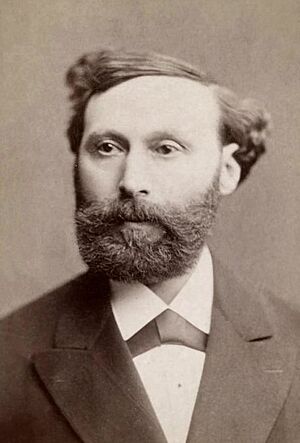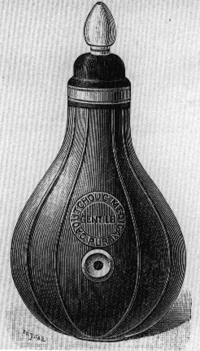Ádám Politzer facts for kids
Ádám Politzer was a very important doctor from Hungary and Austria. He was born on October 1, 1835, in Albertirsa, Hungary, and passed away on August 10, 1920, in Vienna. He is known as one of the first and most important people to study and treat ear problems. This field is called otology.
Politzer's Life and Studies
Ádám Politzer was born in a town called Alberti, which is now part of Albertirsa. His family was well-off.
He decided to study medicine at the University of Vienna. Some of his teachers were famous doctors from the "Vienna School". These included Carl Freiherr von Rokitansky and Josef Skoda. Other important teachers were Joseph Hyrtl, Johann Ritter von Oppolzer, and Carl Ludwig. The last two teachers were very interested in Politzer's work and helped him a lot in his career.
Politzer became a doctor in 1859. He started working in Carl Ludwig's lab. From then on, he was very interested in how the auditory system (our hearing system) works. He was the first to show how certain ear muscles get their signals from the brain. He also studied how air moves through the Eustachian tube, which connects your middle ear to your throat.
In 1861, Politzer shared his first big discovery. He found a new way to treat inner ear diseases. He could blow air into the middle ear through the Eustachian tube. This method was much easier than older ways. It became known as "politzerisation" and made him famous worldwide.
After this, Politzer traveled to learn even more. He worked with many experts in different countries. He studied with doctors like Anton Friedrich Freiherr von Troeltsch and Hermann von Helmholtz. He also went to Paris, France, to learn from Claude Bernard, who is called the "father of physiology." He even studied ear surgery in London, England.
When Politzer returned to Vienna in 1861, he became a professor of otology at the University of Vienna. Two years later, in 1863, he opened a special ear clinic with Josef Gruber. People from all over the world came to their clinic for help. In 1864, the government allowed him to treat poor patients for free.
Politzer and Gruber became full professors in 1870. The next year, they became directors of a new ear clinic at the Vienna General Hospital. This was the first clinic of its kind in the world! Politzer became the only director in 1889 and stayed until 1907. He passed away in 1920 at 85 years old. He is remembered as one of the most important people in the history of ear medicine.
What Politzer Invented and Discovered
Politzer was very good at inventing new medical devices. These tools helped doctors find and treat ear problems. He created many surgical instruments that are still named after him. These include an ear perforator and a special surgical knife. He also made a small tube called a grommet. This grommet helps air get into the middle ear.
He also improved his "politzerisation" method. This uses a pear-shaped rubber bag to help clear the Eustachian tube. Politzer also designed tools to look inside the outer ear canal and at the eardrum. One of these was Politzer's otoscope, which is still used today. He also made an acoumeter to measure how well someone could hear. He even designed some of the first hearing aids.
Politzer changed how doctors looked at ear diseases. He made it possible to see the eardrum clearly using light. He also drew the first detailed atlas of the eardrum. This book showed how the eardrum looked when healthy and when sick. In 1878, he wrote a very important textbook about ear medicine called Lehrbuch der Ohrenheilkunde. He also helped start the first journal just for ear problems.
Politzer was an amazing anatomist (someone who studies the body's structure) of the auditory system. He drew and wrote a lot about it. He also left a huge collection of ear specimens in Vienna. These are now in a museum. The bright spot on your eardrum is named after him. Also, a common birthmark on the back of the neck is called the Unna–Politzer nevus.
In 1893, Politzer was the first to describe otosclerosis. This is a condition where bones in the ear harden, causing hearing loss. He also studied other ear problems like cholesteatoma (a skin growth in the ear), serous otitis media (fluid in the middle ear), labyrinthitis (inner ear swelling), and deafness from birth. He even studied how ear infections could cause problems inside the head.
One person who wrote about Politzer, Albert Mudry, said he was "the greatest ear doctor of the 19th century." Politzer taught thousands of ear doctors from all over the world. One of his most famous students was Robert Bárány. Bárány later won the Nobel Prize for medicine in 1914.
See Also
- Politzerization



